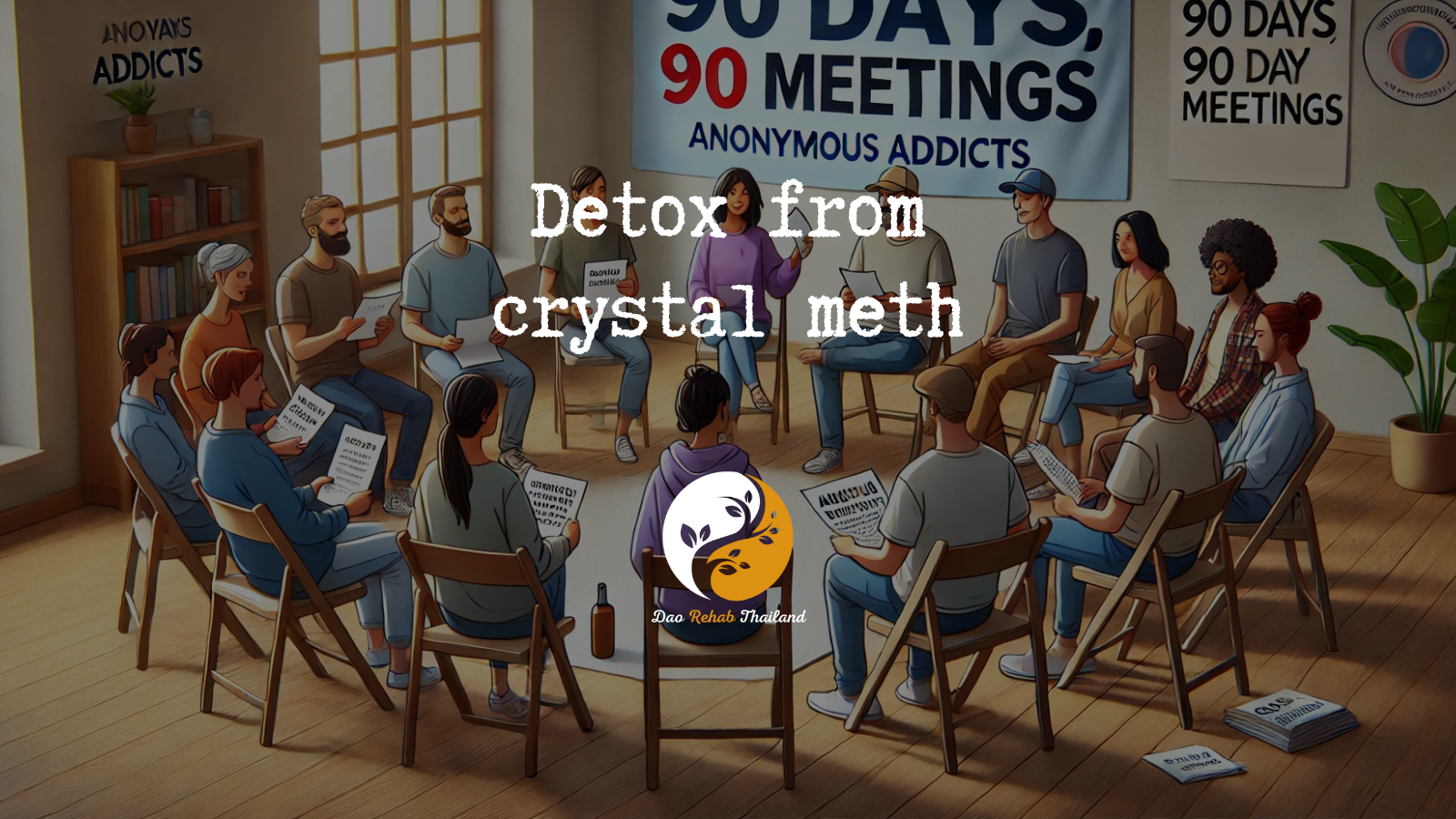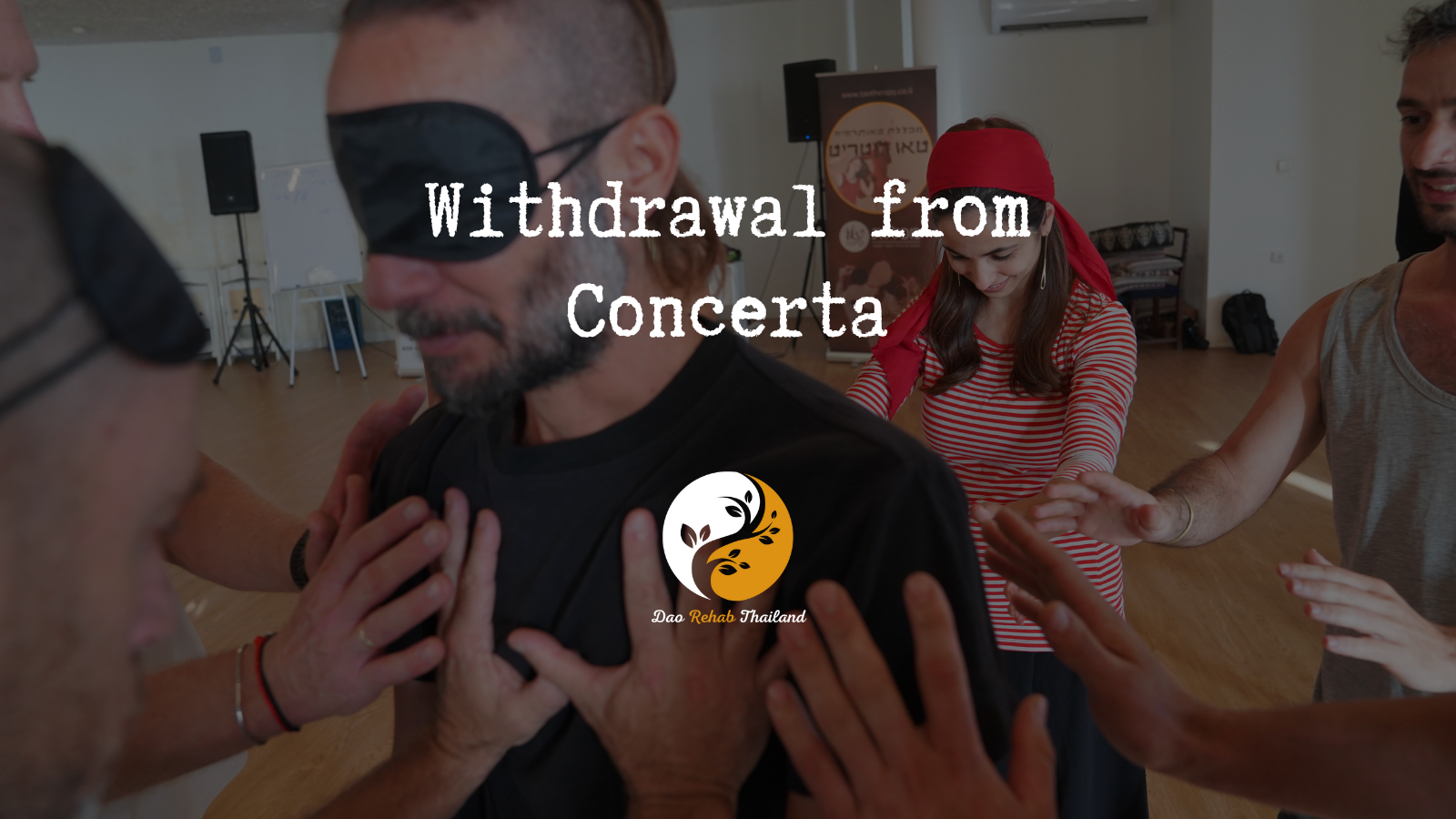
Detox from crystal meth – Treatment in Thailand
Detox From
Crystal Meth
“Turning the impossible into possible”

"Crystal Meth Detox at a Luxury Holistic Center in Thailand and Israel"

Detox From Crystal Meth
“Detox from crystal meth involves a structured process of cleansing the body and mind from the harmful effects of the drug. Our specialized treatment program offers comprehensive support, including medical supervision, psychological therapy, and holistic healing methods to help individuals overcome addiction. Through a combination of personalized care and proven techniques, we provide a safe environment for recovery, promoting long-term wellness and mental clarity. Join us on the path to a healthier, addiction-free life.”
"Holistic Center for Trauma, Addiction, and Mental Imbalance Treatment in Thailand"
“Join the beginning of the journey to freedom from alcohol, drugs, and pill addiction, and rediscover your life in the quiet embrace of DaoTherapy Rehab in Thailand—where holistic healing meets empowering recovery.”
DaoTherapy Holistic Rehab
Turning Love Into a Career
Personalized Treatment Plans: DaoTherapy provides individualized treatment programs tailored to the specific needs of each patient, addressing the physical, emotional, and psychological aspects of crystal meth addiction.
Holistic Healing Approach:
The center integrates traditional therapy with holistic practices, such as meditation, mindfulness, and body-mind therapies, promoting overall wellness and spiritual growth alongside addiction recovery.
Medical Supervision and Safety:
During the detox process, patients receive constant medical monitoring to ensure a safe withdrawal from crystal meth, minimizing the risks of severe withdrawal symptoms.
Trauma-Focused Therapy:
Recognizing the deep connection between trauma and addiction, DaoTherapy offers specialized trauma-focused psychotherapy, helping patients heal from past wounds that contribute to their addictive behaviors.
The historical background of crystal meth:
Crystal methamphetamine (Crystal Meth), also known as methamphetamine, is a powerful and highly addictive stimulant drug that affects the central nervous system. It was first created in a laboratory in the early 20th century, and while initially used for medical purposes, its use became highly problematic over time.
1. Initial Development:
– Late 19th century: Amphetamine, the original drug from which methamphetamine was derived, was first synthesized by Japanese scientist Nagai Nagayoshi in 1893.
– Early 20th century: Methamphetamine was first synthesized in 1919 by Japanese chemist Akira Ogata. The new drug was stronger and acted faster than amphetamine.
2. Military Use:
– World War II: Methamphetamine, known then as Pervitin, was widely used by armies in countries such as Germany and Japan to increase soldiers’ alertness and endurance. It was given to troops to enhance their combat performance and help them stay awake and active for extended periods.
3. Medical Use:
– Mid-20th century: After the war, methamphetamine continued to be used for various medical purposes, including treating depression, weight loss, and attention deficit disorders. Over time, it became clear that the drug posed serious health risks and was highly addictive, leading to more restricted medical use.
4. Illegal Drug Distribution:
– 1970s and 1980s: Methamphetamine became a popular street drug in the United States and other countries. It was produced in illegal laboratories and distributed among various populations.
– 1990s and 2000s: The use of crystal methamphetamine increased significantly and became a severe health and social issue in many parts of the world. Many governments fought the epidemic through legislation, law enforcement, and treatments for addicts.
5. Current Impact:
Methamphetamine remains one of the most dangerous and widespread drugs in the illegal drug market. Its use causes severe physical and mental health problems for users, as well as significant social and economic issues.
Crystal methamphetamine, developed in the early 20th century, has a complex history of military and medical uses, ultimately becoming one of the most dangerous and prevalent illegal drugs today. The health and societal damages caused by its use require serious attention from governments and health authorities worldwide.
The term “Crystal Meth” likely refers to the illegal use of drugs, although this name is not officially recognized in professional literature. It probably refers to the stimulant drug crystal methamphetamine (Crystal Meth), which is a highly potent and addictive stimulant.

contact us
Contact us with your questions
We would love to speak with you! Feel free to reach out with any questions.

get in touch
Schedule a free consultation
Schedule a free consultation with our team and let’s make things happen!
Method of Use of Crystal Methamphetamine (Crystal Meth):
Method of Use of Crystal Methamphetamine (Crystal Meth):
Crystal methamphetamine (Crystal Meth) is consumed in several ways, depending on the desired effect and the method preferred by the user. The most common methods of use include:
1. Smoking: Crystal meth is often smoked using a glass pipe. When smoked, the drug reaches the brain quickly, producing an intense, immediate high. This method is one of the most common and highly addictive due to the rapid effects.
2. Injecting: Some users dissolve the drug in water or alcohol and inject it directly into the bloodstream using a syringe. This method results in an extremely intense and rapid high, but it also carries significant risks, such as infections, transmission of diseases, and damage to veins.
3. Snorting: Crystal meth can also be crushed into a fine powder and snorted through the nose. While this method doesn’t produce effects as quickly as smoking or injecting, the high is still intense and long-lasting.
4. Ingesting: Ingesting crystal meth by swallowing the drug in pill or powder form is another method, though it tends to produce effects more slowly compared to smoking or injecting. The drug passes through the digestive system before entering the bloodstream.
Each method of use carries significant health risks, including addiction, overdose, and severe physical and mental side effects. Smoking and injecting are considered particularly dangerous due to the rapid onset of effects and increased likelihood of addiction.
Effects and Side Effects of Crystal Methamphetamine (Crystal Meth):
Effects and Side Effects of Crystal Methamphetamine (Crystal Meth):
Crystal methamphetamine (Crystal Meth) has both short-term and long-term effects on the body and mind. These effects can be severe and highly damaging.
Short-Term Effects:
1. Euphoria: Users experience a strong sense of pleasure, heightened energy, and increased confidence.
2. Increased Alertness: Crystal meth stimulates the central nervous system, resulting in heightened alertness and decreased fatigue.
3. Loss of Appetite: Meth reduces feelings of hunger, often leading to rapid weight loss.
4. Increased Physical Activity: Users may feel unusually active, restless, and driven to engage in repetitive or aggressive behavior.
5. Rapid Heart Rate and Increased Blood Pressure: These effects increase the risk of heart attacks or strokes, even in younger users.
Long-Term Effects:
1. Addiction: Crystal meth is extremely addictive, with users quickly developing a dependency on the drug.
2. Severe Dental Problems (“Meth Mouth”): Chronic use leads to tooth decay, gum disease, and other oral health problems.
3. Memory Loss and Cognitive Decline: Long-term use can impair memory, concentration, and decision-making abilities.
4. Paranoia and Hallucinations: Chronic users often suffer from severe paranoia, delusions, and visual or auditory hallucinations.
5. Violent Behavior: Prolonged use can result in increased aggression and violent tendencies.
6. Extreme Weight Loss: Due to its appetite-suppressing effects, many users experience dramatic and unhealthy weight loss.
7. Skin Sores and Infections: Users may develop skin sores or infections due to obsessive scratching or injecting the drug.
8. Heart Problems: Chronic use significantly raises the risk of heart attacks, high blood pressure, and cardiovascular disease.
Mental Health Side Effects:
1. Anxiety and Depression: Long-term users often suffer from severe anxiety, mood swings, and depression during or after use.
2. Psychosis: Many users experience episodes of meth-induced psychosis, which include paranoia, hallucinations, and delusional thinking.
3. Social Isolation: Due to behavioral changes and mental health issues, users often withdraw from family and friends.
Overall, the effects and side effects of crystal meth are incredibly harmful, and prolonged use can lead to irreversible damage to both physical and mental health.
"Crystal Meth Addiction"
From a pharmacological perspective, the effect of methamphetamine on the body acts as a stimulant on the central nervous system. The drug influences neurochemicals responsible for heart rate, body temperature, blood pressure, appetite, attention, mood, and also affects alertness through pain mechanisms.
Ways of Administration:
Crystal meth can be ingested by swallowing, snorting, injecting, smoking, or rectally (through the anus). Like all addictive drugs, the likelihood of becoming addicted increases the faster the drug enters the bloodstream and the more rapidly its effects are felt. The level of enjoyment (the main “driving force” behind addiction) depends on how quickly the concentration of the drug in the bloodstream rises.
Smoking the drug is often considered the “fastest” method (meaning smoking causes the drug’s concentration in the blood to rise quickly and efficiently reach the brain and central nervous system, the drug’s main site of action). After smoking, the fastest methods of consumption are, in descending order: injecting, snorting, and swallowing. The quicker the drug takes effect, the shorter its duration of action.
Extreme and Rapid Effects of Crystal Meth:
The quick addiction to crystal meth leads to severe short-term and long-term effects.
Crystal meth can cause the following:
– Increased alertness and brain activity
– Enhanced self-confidence and motivation
– Pleasure and satisfaction
– Euphoria in larger doses
– Loss of appetite
– Sexual arousal
– Increased blood pressure
– Dilated pupils
Potential Side Effects and Damage from Crystal Meth Use:
– Diarrhea and nausea
– Skin rashes
– Increased body temperature
– Restlessness
– Strong psychological addiction
– A sensation of itching, often described as “bugs crawling under the skin,” leading to scratching until bleeding
– Impotence
– Teeth grinding and clenching, eventually leading to severe damage to teeth and gums
– Kidney damage
– Liver damage
– Immune system impairment
– Antisocial or hostile behavior
– Death from overdose, especially when combined with other drugs
There is an additional risk associated with crystal meth use. Having sex under the influence of drugs, known as “ChemSex,” typically involves three main types of drugs: mephedrone, crystal meth, and GHB (G).
All of these drugs have a “libido-boosting” effect and help with heightened alertness. When using these drugs, often in dangerous combinations, people can engage in sexual activity for hours or days, feeling a strong sense of self-confidence and less sensitivity to pain. However, in addition to the risks associated with drug use, users often suffer from injuries that can lead to infections, including sexually transmitted diseases and HIV (AIDS).
DaoTherapy was founded from a profound vision of someone who truly understands human suffering.
Our Process
Our process is designed to offer a holistic and personalized path to healing, focusing on every aspect of an individual’s well-being—physical, emotional, and spiritual. We begin with an in-depth assessment to understand each person’s unique challenges and needs. From there, we develop a customized treatment plan that may include detox, trauma-focused therapy, mindfulness practices, and body-mind healing methods.
Our Mission
Our mission is to provide comprehensive, compassionate care to individuals suffering from trauma and addiction, guiding them toward healing and personal transformation. We are dedicated to offering a holistic approach that integrates therapeutic, spiritual, and emotional practices, fostering long-term recovery and well-being. Through personalized treatment programs, a supportive community, and innovative methods, we aim to empower individuals to reclaim their lives, achieve inner balance, and thrive in a healthier, more fulfilling future.
Our Vision
Our vision is to create a world where individuals struggling with trauma and addiction can find a path to healing, personal growth, and spiritual awakening. We are committed to integrating ancient philosophies with modern therapeutic practices, offering a holistic approach that nurtures the mind, body, and soul. Our goal is to provide compassionate care, innovative therapies, and a supportive community, empowering individuals to overcome their challenges and lead fulfilling lives, contributing to the well-being of society.
Addiction and Dependence on Crystal Meth:
Addiction and Dependence:
Crystal meth is highly addictive. Some users report becoming dependent after only one or two uses, and it is considered about three times more addictive than cocaine. Many users who became addicted to crystal meth stated that they never saw themselves as “people who get addicted easily.”
The severe damage to the central nervous system decreases as the concentration of the drug in the blood drops.
Many users compensate for the loss of the drug’s effects by taking larger amounts to maintain a stable level of euphoria and alertness. The decreased threshold of stimulation and the increase in methamphetamine consumption often cause users to stay awake for extended periods. Sleep deprivation leads to irritability, blurred vision, memory loss, confusion, paranoia, and nausea. After prolonged use, methamphetamine users develop irritability due to lack of sleep and irregular sleeping patterns.
From High to Depression and Suicidal Thoughts: The Stages of Crystal Meth’s Effects:
1. The Rush Stage:
The drug enters the bloodstream and causes a rapid heart rate and an increase in blood pressure. This stage lasts about half an hour.
2. The High Stage:
The body experiences sharp focus, energy, repetitive behavior, euphoria, and increased sexual desire. This stage can last four to 16 hours.
3. The Binge Stage:
The user seeks to continue taking more doses of the drug to repeatedly experience the same feelings. This stage can last up to two weeks. During each use, the user experiences the High and Binge stages until the body no longer responds to the drug.
4. The Tweaking Stage:
When crystal meth no longer produces the desired effect and the user cannot feel relief, this stage is accompanied by feelings of emptiness, hunger, and loss of identity. Sometimes, this stage includes chills, itching, and even hallucinations that feel entirely real. In this stage, the user may harm themselves or others.
5. The Crash Stage:
A shock response of the body after prolonged drug use. During this stage, there is a desire for prolonged sleep, which can last up to three days.
6. The Hangover Stage:
After awakening from the Crash stage, the user feels disoriented, dehydrated, chronically tired, and exhausted. This stage can last up to two weeks.
7. The Depression Stage:
“The higher crystal meth takes you, the lower it drops you.”
8. The Depression Stage:
A stage of low energy and a craving for more of the drug, often accompanied by suicidal thoughts.
Detox and Treatment:
Methamphetamine is highly addictive, particularly from a psychological standpoint. Detoxing from the drug involves difficult social and mental processes for the addicted individual. As with all detox processes, relapse rates are high. To combat the tendency to relapse, detox programs often include the 12-step process and support groups such as Narcotics Anonymous.
It is important to combine individual and group therapy tailored to each person’s needs.
Former addicts have noted that they feel stupid or bored when they stop using crystal meth. This feeling arises because the brain had adapted to the presence of the drug to think faster or at a “higher level,” and after discontinuing use, the reduced brain activity leads to these sensations.
Crystal meth addiction is challenging and dangerous, but there is a way out. You are not alone! Anyone can seek help and find support to escape the suffering and embark on a new, healthier life path.
studies conducted on crystal meth
there have been many studies conducted on crystal meth (methamphetamine) over the years, addressing various aspects of its use, its physiological and psychological effects, and the detoxification process. Here are some key research areas:
1. Neurological Effects:
Many studies focus on the effects of crystal meth on the brain and central nervous system. Methamphetamine use causes a large release of dopamine in the brain, resulting in feelings of euphoria and high energy, but over time, it also damages neurological networks, leading to memory loss, cognitive decline, and impaired learning ability. Research has shown that prolonged methamphetamine use can cause irreversible changes to the brain’s structure.
2. Psychological Effects:
Research also explores the connection between methamphetamine use and mental health disorders such as paranoia, depression, anxiety, hallucinations, and psychosis. These studies show that chronic use of the drug increases the risk of developing psychotic episodes and paranoid delusions. These effects may persist even after stopping the drug, making recovery more difficult.
3. Addiction and Dependency Development:
Studies in addiction and treatment indicate that crystal meth is one of the most addictive substances, influencing the brain in ways that increase the urge for repeated use. Researchers are working to understand the psychological and biochemical mechanisms involved in crystal meth addiction in order to develop more effective treatment methods.
4. Physiological Effects:
Researchers are also examining the physiological effects of methamphetamine on the body, including damage to the immune system, heart and blood vessels, liver, and kidneys. Additionally, there is a focus on dental and gum problems common among chronic users (known as “Meth Mouth”).
5. Detox and Treatment Programs:
Numerous studies analyze the effectiveness of different treatment methods for crystal meth addiction, including 12-step recovery programs, Cognitive Behavioral Therapy (CBT), and holistic approaches like meditation and mindfulness. These studies focus on the success of these treatment programs in reducing side effects and minimizing the risk of relapse.
6. Trauma and Addiction Connection:
Some research focuses on the link between past trauma and methamphetamine use. These studies show that many users turn to the drug as a result of emotional trauma or other difficult experiences, highlighting the need for trauma-focused therapy in rehabilitation programs.
7. Social and Economic Spread:
In addition to medical and psychological research, social and economic studies examine the impact of crystal meth use on communities, healthcare systems, and economies. These studies describe how addiction to the drug affects families, employers, and society as a whole, and how the phenomenon can be fought through policies and law enforcement.
In conclusion, crystal meth is a comprehensive research subject across the globe, with findings continuing to contribute to the development of more effective detox and rehabilitation programs.
Detox and Treatment Programs for Crystal Meth Addiction
“Detox and Treatment Programs for Crystal Meth Addiction” are a significant and central area of research, given the complexity and challenges of treating addiction to this drug. The powerful and addictive effects of crystal meth on both body and mind require diverse and integrative treatment approaches, combining medical, psychological, and social interventions. Below is an expansion on the key research areas and treatment methods in this field:
1. 12-Step Program:
Studies show that the 12-step program, known from groups like “Narcotics Anonymous,” is one of the common approaches for treating severe addictions like crystal meth. The program is based on group support, acknowledging a lack of control over addiction, and surrendering to a higher spiritual or moral power. Research indicates that this method is effective in reducing drug use, especially when accompanied by individual or group therapy. However, challenges remain in maintaining participation over time, particularly when a strong support network outside the group is lacking.
2. Cognitive Behavioral Therapy (CBT):
Cognitive Behavioral Therapy (CBT) is a well-researched approach in treating crystal meth addiction. This approach focuses on identifying and changing negative thought patterns and harmful behaviors that lead to drug use. Studies show that CBT is effective in many cases, teaching patients how to cope with triggers, manage social and emotional pressures, and improve coping skills. CBT also helps reduce cravings and decreases the risk of relapse.
3. Medication-Assisted Treatment (MAT):
Although there is no specific medication approved for treating crystal meth addiction, research into medication-assisted treatment is ongoing. Drugs such as “Naltrexone” and “Modafinil” are being studied for their potential to reduce cravings and improve cognitive function in addicts. Additionally, medications are being tested to alleviate withdrawal symptoms like depression, anxiety, and insomnia, which are common during crystal meth detox. While research on medications is still in early stages, there is hope for the development of more effective treatments in the future.
4. Holistic Treatment Approaches:
Research shows that integrating holistic methods into detox programs, such as “meditation”, “yoga”, “mindfulness”, and “body-mind therapy”, can improve the chances of successful recovery from crystal meth. These methods help patients stabilize their mental and emotional systems, develop self-awareness, and enhance their ability to cope with stress. Additionally, these treatments offer a more comprehensive healing approach by strengthening the mind-body connection and improving participants’ quality of life.
5. Group and Community Therapy:
Studies suggest that group therapy has significant value in the recovery process from crystal meth addiction, as it allows patients to support each other, share similar experiences, and feel less alone in the process. Focused group therapies address topics such as emotion management, dealing with cravings, and strengthening life skills. Community-based therapy, often conducted in closed rehabilitation settings, provides a safe and monitored environment where participants can redevelop social and emotional skills. These community settings offer a strong support network that helps prevent relapse after discharge.
6. Long-Term Rehabilitation and Relapse Prevention:
Research in addiction treatment indicates that crystal meth addiction requires long-term rehabilitation programs. Short-term treatment is often insufficient for complete recovery, and ongoing medical supervision, emotional therapy, and community support are recommended. Long-term rehabilitation may include inpatient care, protected housing arrangements, and extended psychological follow-up. Studies have found that continued treatment, even after completing the initial detox process, significantly reduces the risk of relapse.
Conclusion:
Crystal meth detox programs are diverse and incorporate various approaches, from medication-assisted treatments to holistic methods. Treatment success often depends on a combination of methods tailored to each individual’s needs, alongside ongoing professional guidance and support. Research shows that designing an individualized treatment plan for the patient, incorporating cognitive behavioral therapy, group support, and a holistic approach, improves long-term success rates and helps in dealing with crystal meth addiction.
what makes us different in dao-rehab
Innovative Therapies:
We integrate cutting-edge therapeutic techniques with traditional practices to offer a holistic and comprehensive treatment experience. From the latest advancements in behavioral therapy to innovative mindfulness practices, we are constantly evolving our methods to ensure the highest standard of care.
Creative Expression:
We encourage creative expression as a vital part of recovery. Through art therapy, music, writing, and other creative outlets, our clients are able to explore their emotions, gain new insights, and discover inner strengths. These activities not only support emotional healing but also foster a sense of empowerment and self-discovery.

We Are a Role Model
At DaoTherapy Rehab Thailand, we see ourselves as a role model in the field of rehabilitation and addiction treatment. Our expertise, combined with our holistic and innovative approach, sets us apart as leaders in the industry. We uphold the highest standards of care and are dedicated to providing each client with the tools they need to live a full, balanced, and meaningful life. Our commitment to continuous improvement, attentive care for each individual's needs, and the use of cutting-edge treatment methods establish us as a role model in addiction treatment.
Radical Acceptance
Radical Acceptance is a key concept at DaoTherapy Rehab Thailand, where we encourage individuals to fully embrace their reality without resistance. By acknowledging and accepting even the most difficult emotions and situations, clients can release the struggle against what cannot be changed and focus on healing. This practice, integrated into our therapy and mindfulness sessions, empowers individuals to move forward with greater peace and resilience.








